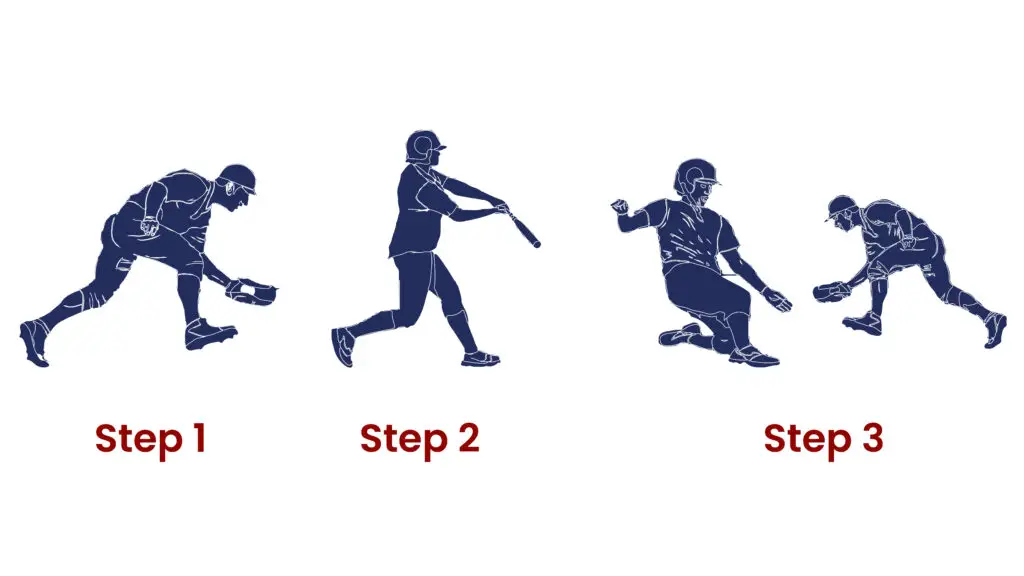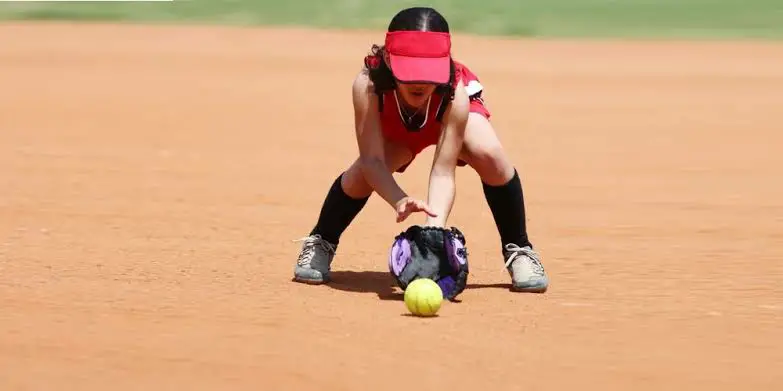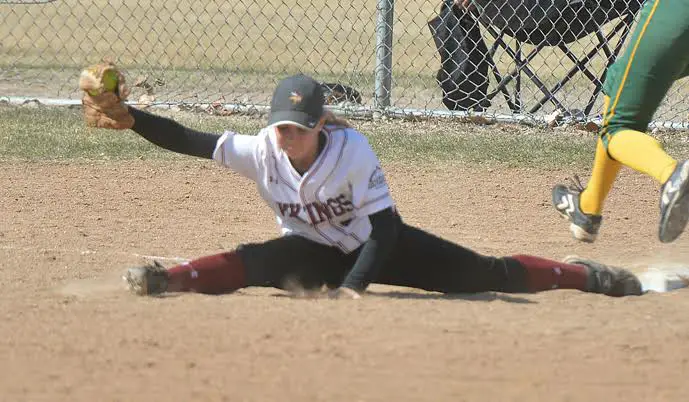Moving and reacting fast around the first base is crucial, as is the ability to adapt your footing on the fly depending on the precision of the throw you’re fielding.
First basemen are often bigger and have more of an impact at bat. A club with a competent first baseman is less likely to give up easy outs. Listed below, we’ll go over some of the duties of a first baseman and offer some advice that should help you get up to speed on the position.

What is the role of the first baseman in softball defense?
The first baseman’s starting position for every play must consider the current number of runners on base. When the ball is played, first basemen should move to the bag instead of staying in the conventional position unless they are holding a runner.
When a runner is on first and attempting to steal, the defender must be ready to pick up the pitcher’s throws by extending his arm toward the base runner. First basemen are expected to seek out the sure out at all times actively.
Although it’s human nature to go after the runner in the lead, a fielder should be wary of taking needless risks that could cause him to miss out on a potential out.
Taking up a defensive stance
First basemen should constantly be alert before a pitch is thrown, either waiting for a hit their way or prepared to make a hasty run to the base to catch a throw from another infielder. At first base, you’ll either be standing in the usual off-the-bag stance or, if the runner is safe, you’ll be on the bag with him.
If there are no runners on base, the first baseman does not need to take up a position there. The correct position is at first base, where they can easily field a ball batted in their direction. The first baseman shouldn’t be there if a runner is already on first base.
The first baseman’s primary objective should be to prevent the advancing of the runner in the lead. The first baseman should always be ready to try a pickoff, especially if there is another runner on second base if the bases are loaded. If the catcher can throw out a runner at second base, holding him at first base is a viable option while runners are on first and third. Keeping the runner on base improves the odds of getting the force out at second on the next at-bat if the batter hits an infield ground ball.
In the event of a pickoff, the pitcher and first baseman should be able to communicate well. Holding a runner initially requires little more than making eye contact and using modest gestures. If the pitcher throws first, the first baseman should hold the runner on as usual and prepare to slap the runner with a tag as soon as he gets the ball. Also possible after a pitch is thrown if the catcher attempts to “back-pick” the runner at first.
Catching Ground Balls
Ground balls at first base are relatively easy to field because of their low trajectory. After catching a ball in your direction, you take one step onto the first base to record an out.
A double play or getting the lead runner out might be difficult if the ball pulls you too far off the base or if there are other runners on. In the event of a ground ball that forces the first baseman to travel a great distance from the base, the runner at first base must be replaced by another player.

Depending on where the ball is hit, this task is usually assigned to the pitcher or the second baseman. A first baseman’s strong arm is helpful in numerous scenarios, especially when attempting to start or turn a double play.
If a runner is on first base and the ball is fielded and thrown to second, the out will be a force out; if the ball is fielded and touched first base before being thrown to second, the out will be a tag out.
The first baseman should only start a double play from home plate with the bases loaded and the infield in; at no point should he attempt to initiate a double play from third base. There are times when the pitcher must cover first base, such as when a bunt or ground ball to the first baseman forces him off the bag.
After fielding the ball, quickly feeding it to the pitcher in stride will allow them to safely step on first base and then pull out to the side to avoid the batter running down the line. It is customary to underhand the ball to the pitcher.
First basemen are expected to make solid throws to the pitcher protecting the first base, but occasionally a ball will carry them well off the bag.
The first baseman should sprint toward home plate as the pitcher releases the ball to field a bunt with a runner on first. The throw must be made where the shortstop is stationed at second base if the throw is accurate enough to catch the runner coming from first. If not, you should hit first (where you should find the second baseman covering).
Fielding Pop-ups
First basemen must take extra care when fielding pop-ups since they must avoid touching first base and must, in most cases, make their plays in foul territory. If you’re the first baseman and you have the option to call off the pitcher or catcher on a pop-fly, you should always take advantage of it. You can make the catch on the run much quicker than the catcher with all his equipment, and the pitcher has to do so because of the slanted mound.
It’s the most straightforward aspect of playing first base, provided the ball is hit squarely towards your chest. Keep the foot of the gloved hand that is not fielding the throw on the bag when catching the ball to ensure an out is made.
It’s not easy to field these throws at first base. Balls tend to bounce in quite peculiar ways when tossed into the dirt. Keep your head up and your glove ready to make a scooping motion toward the ball. To avoid missing the ball or not catching it cleanly, avoid jabbing at it to get it out of the soil.
It’s easier to catch than throws in the dirt, but it’s still not easy. To record an out when fielding a throw off the bag, the catcher must extend one arm as far as possible and reach in that direction to collect the ball while maintaining the other foot on the bag.
The first baseman position requires a great deal of adaptability. The faster the ball will reach your glove if you can extend to great lengths. You might amaze onlookers by dropping to a full split to catch the ball to get the runner out on a bang-bang play.
Conclusion

Knowing the play quickly and having a decent first base glove are necessities at first base. It takes practice and familiarity with their strategy to anticipate where they will be standing before the ball is pitched. If you want to be an excellent first baseman, you should study the positions of other first basemen and try to picture yourself there. Practice each scenario and consult your coaches about the opposition.
